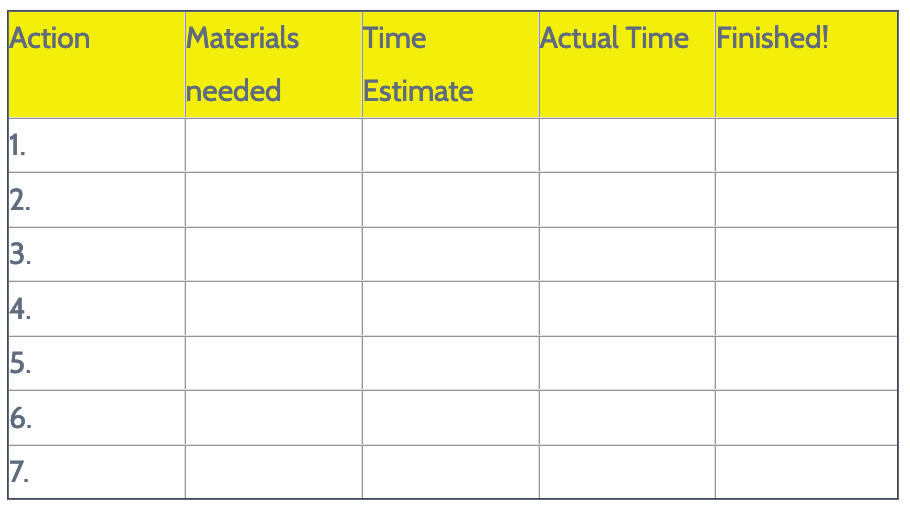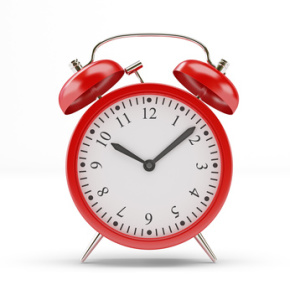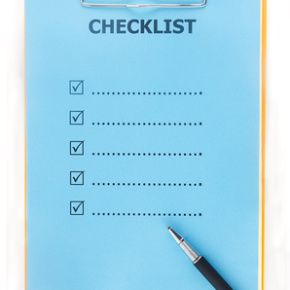 Whether it’s writing a paper or cleaning up your desk, some projects are just hard to get to and even harder to finish. You simply consider organizing the mound of papers and junk on your kitchen table and a wave of fatigue sweeps over you, causing you to run suddenly for the couch in front of the television or your comfortable bed. Or, you mention the dreaded task like writing that college essay and your daughter suddenly has field hockey practice and hastily leaves the house. Starting a task that seems unpleasant or problematic, creating steps to move it along, and then completing it can be challenging for EVERYONE, especially people with ADHD. The project, the chore, and the paper all seem insurmountable because they appear overwhelming. The key to to success is breaking them into manageable parts. When you, your child or student create a customized plan that creates these , then you are already on the road to completion. Although there are many how-to forms for homework, chores and long-term projects, many of them are complicated and labor intensive. The goal of using any form is to provide structure for the planning, prioritizing and sequencing aspects of executive functioning skills that get you from the beginning to the end of a task. Here’s how you can create your own forms that suit you (and your child’s) specific management skills which will take some effort in the beginning but will definitely yield results. You will need a pen and a piece of paper.
Whether it’s writing a paper or cleaning up your desk, some projects are just hard to get to and even harder to finish. You simply consider organizing the mound of papers and junk on your kitchen table and a wave of fatigue sweeps over you, causing you to run suddenly for the couch in front of the television or your comfortable bed. Or, you mention the dreaded task like writing that college essay and your daughter suddenly has field hockey practice and hastily leaves the house. Starting a task that seems unpleasant or problematic, creating steps to move it along, and then completing it can be challenging for EVERYONE, especially people with ADHD. The project, the chore, and the paper all seem insurmountable because they appear overwhelming. The key to to success is breaking them into manageable parts. When you, your child or student create a customized plan that creates these , then you are already on the road to completion. Although there are many how-to forms for homework, chores and long-term projects, many of them are complicated and labor intensive. The goal of using any form is to provide structure for the planning, prioritizing and sequencing aspects of executive functioning skills that get you from the beginning to the end of a task. Here’s how you can create your own forms that suit you (and your child’s) specific management skills which will take some effort in the beginning but will definitely yield results. You will need a pen and a piece of paper.
- Choose the topic or task and write that on the top of the paper.
- Make a grid with 3 vertical columns and several horizontal ones. Label the columns “Possibilities, Pros, Cons.” It should look like this:

- Put any ideas about the project in the possibilities column, followed by what is good and bad about that idea. For example, if the task is organizing the stuff in the basement, the possibilities list might range from “taking everything to the dump” to “getting rid of anything that I haven’t used in 5 years.”
- Create the sequential steps needed to accomplish the task using another grid with 5 vertical columns and several horizontal ones. Use the labels suggested below OR create your own. Make as many numbered rows as required to finish the project. Make the actions as specific as possible. Estimating the time it takes to do a step and then comparing that guess with the actual time the passed improves those all-important time management skills as well!
 Although many kids and adults with ADHD often reject the structure and practice of this process, I have found that my clients ultimately embrace such programs and find them extremely helpful. These “roadmaps” reduce anxiety, clarify goals and build confidence as activities are completed. So, swallow any resistance and try one today!
Although many kids and adults with ADHD often reject the structure and practice of this process, I have found that my clients ultimately embrace such programs and find them extremely helpful. These “roadmaps” reduce anxiety, clarify goals and build confidence as activities are completed. So, swallow any resistance and try one today!




 2. Time management: I talked about backwards design, which seemed to be a new concept. We looked at how challenging it can be to get ready and out of the house on time for school in the morning. With the eager participation of one mother and daughter, we traced their morning routine as it unfolds now with all of its bumps and then rearranged it by going backwards from the time of arrival at school. The audience found this technique very useful. I really appreciated the frank feedback that the Jamaicans gave right after my talk—“I liked the part about learning how to make better decisions but not so much about the brain cells”—and their warmth and humor. It was refreshing (and a bit comforting) to see that parents and teens in the Caribbean have many of the same questions and concerns that we have here in the USA.
2. Time management: I talked about backwards design, which seemed to be a new concept. We looked at how challenging it can be to get ready and out of the house on time for school in the morning. With the eager participation of one mother and daughter, we traced their morning routine as it unfolds now with all of its bumps and then rearranged it by going backwards from the time of arrival at school. The audience found this technique very useful. I really appreciated the frank feedback that the Jamaicans gave right after my talk—“I liked the part about learning how to make better decisions but not so much about the brain cells”—and their warmth and humor. It was refreshing (and a bit comforting) to see that parents and teens in the Caribbean have many of the same questions and concerns that we have here in the USA. Parents and teachers often complain to me that kids with ADHD don’t remember things they are told. This forgetfulness happens for a number of reasons—poor working memory, internal or external distractions, limited ability to sequence information into steps, anxiety about forgetting—and changing how you talk to a child or teen with ADHD can improve memory. When you are asking someone with ADHD to do something, that request should only have one component. The chances of him or her remembering more than one thing at a time are very slim, even with the aide of medication. So, keep your task SIMPLE. The rule of three is critical to successfully making these changes. 1. Say the youngster’s name. 2. Look directly at him/her AT EYE LEVEL, making sure your gaze is returned and held. 3. State your task clearly and calmly. Ask the child or teen to repeat your request EXACTLY and then, ask for a second repetition. These three steps have to be followed in this sequence in order for them to work most effectively. They activate several ways for connecting—sight, sound, repetition–that trigger different and simultaneous neural pathways. When the single task is completed, then you can give another one in exactly the same manner. Communicating in this easy, direct manner improves the likelihood that the task is remembered and completed. Everyone will be less frustrated and feel more confident that things actually get done!
Parents and teachers often complain to me that kids with ADHD don’t remember things they are told. This forgetfulness happens for a number of reasons—poor working memory, internal or external distractions, limited ability to sequence information into steps, anxiety about forgetting—and changing how you talk to a child or teen with ADHD can improve memory. When you are asking someone with ADHD to do something, that request should only have one component. The chances of him or her remembering more than one thing at a time are very slim, even with the aide of medication. So, keep your task SIMPLE. The rule of three is critical to successfully making these changes. 1. Say the youngster’s name. 2. Look directly at him/her AT EYE LEVEL, making sure your gaze is returned and held. 3. State your task clearly and calmly. Ask the child or teen to repeat your request EXACTLY and then, ask for a second repetition. These three steps have to be followed in this sequence in order for them to work most effectively. They activate several ways for connecting—sight, sound, repetition–that trigger different and simultaneous neural pathways. When the single task is completed, then you can give another one in exactly the same manner. Communicating in this easy, direct manner improves the likelihood that the task is remembered and completed. Everyone will be less frustrated and feel more confident that things actually get done!
 As the trees and flowers begin to bloom, many parents take a look around their homes and long to clean out the family nest. Sometimes, the task seems just too overwhelming and you don’t get any further than a big sigh. At other times, you start with the best intentions but can’t get past the battles about what to keep and what to get rid of. Here are some simple steps that you can use to organize the belongings of your children or teens this spring (and maybe even your own)! The path to organizing success involves the 3 P’s: patience, perseverance and practice. It requires a sense of humor and the ability to keep focused on your goal. Improve collaboration with your son or daughter and avoid power struggles by using the following steps:
As the trees and flowers begin to bloom, many parents take a look around their homes and long to clean out the family nest. Sometimes, the task seems just too overwhelming and you don’t get any further than a big sigh. At other times, you start with the best intentions but can’t get past the battles about what to keep and what to get rid of. Here are some simple steps that you can use to organize the belongings of your children or teens this spring (and maybe even your own)! The path to organizing success involves the 3 P’s: patience, perseverance and practice. It requires a sense of humor and the ability to keep focused on your goal. Improve collaboration with your son or daughter and avoid power struggles by using the following steps:  1. Choose your target carefully. Make it manageable and give it a specific period of time. For example, go for cleaning out JUST the closet and give yourself a limit of around an hour. Or, concentrate on picking things off the floor and do the closet on a different day. Keep track of the time so you don’t run out! 2. Engage your child or teen in the process, using incentives. This means offering your child or teen something s/he may want to do as a reward for working with you on this project. Examples may include extra screen time (tv or computer or gaming systems), fun activity (biking, board games, playing sports), time with friends or a special food treat. 3. Get 4 bags and label each one: “keep”, “trash”, “give away”, “unsure”. Divide the STUFF into these bags. If your child or teen has trouble with letting go of belongings, help him or her make choices by talking about what is really being used and how someone else might want what your son or daughter does not. When you have your 4 bags, go through the “unsure” bag carefully one more time, putting its contents in the other 3 bags. Then put away the “keep” items immediately and deal with the “trash” and “give away” bags. Remember it is critical to value what you have done together. Look at your accomplishment and congratulate yourselves on the success of your efforts!!
1. Choose your target carefully. Make it manageable and give it a specific period of time. For example, go for cleaning out JUST the closet and give yourself a limit of around an hour. Or, concentrate on picking things off the floor and do the closet on a different day. Keep track of the time so you don’t run out! 2. Engage your child or teen in the process, using incentives. This means offering your child or teen something s/he may want to do as a reward for working with you on this project. Examples may include extra screen time (tv or computer or gaming systems), fun activity (biking, board games, playing sports), time with friends or a special food treat. 3. Get 4 bags and label each one: “keep”, “trash”, “give away”, “unsure”. Divide the STUFF into these bags. If your child or teen has trouble with letting go of belongings, help him or her make choices by talking about what is really being used and how someone else might want what your son or daughter does not. When you have your 4 bags, go through the “unsure” bag carefully one more time, putting its contents in the other 3 bags. Then put away the “keep” items immediately and deal with the “trash” and “give away” bags. Remember it is critical to value what you have done together. Look at your accomplishment and congratulate yourselves on the success of your efforts!!

